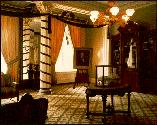The Treasury Building served as the location of the temporary White House in 1865 when Andrew Johnson assumed the presidency following the assassination of Abraham Lincoln. The presidential association, coupled with historic documentation for furnishing the rooms, makes the Andrew Johnson Suite one of the most significant spaces in the Treasury Building.

The assassination of Lincoln came at a critical time in our country's history, just one week after the surrender of the Confederate Army. The President's plans to reunite the country were interrupted on April 14, 1865 when John Wilkes Booth fired a fatal shot at Lincoln. The following morning Lincoln died, making his vice-president, Andrew Johnson, the seventeenth president of the United States.
As a courtesy to Mary Todd Lincoln, Johnson delayed moving into the White House, allowing Mrs. Lincoln time to recover and plan her departure. In the meantime, Secretary of the TreasuryHugh McCulloch offered his recently decorated reception room for the President's official use. Here, within hours of Lincoln's death, Andrew Johnson held his first cabinet meeting in what would be his temporary executive office for the next six weeks.
During the time that Johnson was at the Treasury Department, he worked methodically and deliberately to calm the country. Numerous delegations, including representatives from various states, visited him. A recurring theme in Johnson's addresses to such groups was the assertion that he would continue the policies set forth by Lincoln. Newspaper articles also reported that the American people were anxious to express their support for the new president.
While at Treasury, President Johnson held a reception for foreign ambassadors, one of the first official functions of his presidency. Johnson also issued a $100,000 warrant for the arrest of Confederate President Jefferson Davis who, at the time, was suspected of conspiring in the assassination of Lincoln.
Exhibited in the suite is a reproduction of the Treasury Guard Flag, the original of which was draped across the presidential box on the April evening President and Mrs. Lincoln attended Ford's Theater. When John Wilkes Booth jumped to the stage after shooting the president, he caught his spur in the Treasury Guard Flag, causing him to break his leg upon landing. After Lincoln's death, the torn flag was brought back to Treasury and displayed in the corridor outside the Secretary's suite as a symbol of the nation's tragedy.
Research and Restoration of the Andrew Johnson Suite


In 1863, the Treasury Department commissioned a New York decorating firm, Pottier & Stymus, to design and furnish the rooms occupied by the Secretary of the Treasury. This suite was used by the Secretary of the Treasury from 1864 to 1875.
Pottier & Stymus' commissions included the decoration of the White House Cabinet Room under President Grant and late nineteenth century commissions from clients such as William Rockefeller, Frederick Steinway, and the New York Plaza Hotel. At the time the firm decorated the Treasury offices, they employed nearly 700 men.
Invaluable in identifying furnishings for the restoration were Pottier and Stymus' original invoices and floor plans, historic engravings from period newspapers, and written descriptions. Careful research led to the reproduction of period carpets woven in 27 inch widths, walnut window cornices and tiebacks, and gilded chandeliers. The Renaissance Revival style furniture is ornamented with gilded and ebonized details. The sofa and arm chairs with shields on the back crest appear in an 1865 engraving of the room and are part of the historic Treasury furniture collection. As part of the restoration project, these pieces were reupholstered in period horsehair and plush and returned to the suite.
To determine the suite's original paint scheme, research was conducted using paint samples taken from both rooms' architectural features including the moldings, the ceiling medallion, and columns. These samples, when examined under a microscope, revealed a complete chronology of paint layers and color during the suite's history. Once the original colors were identified, the suite was painted accordingly and gold leaf was reinstated on the entablature, door, and window frames. Paint analysis conducted on one of the suite's original doors revealed that it was made from pine then faux grained to look like oak. During restoration, skilled craftsmen applied this graining technique on all of the suite's doors to create a similar effect.
We appreciate the help of Treasury's Office of the Curator in providing and maintaining this information. The Curator wishes to acknowledge the City of Bridgeport, the Barnum Museum (loan of furniture) Corcoran Gallery of Art (loan of Andrew Johnson portrait) Darby Foundation (purchase of textiles) Treasury Historical Association (donation of artwork)
The restoration of the Andrew Johnson Suite was funded by private donations raised by the Committee for the Preservation of the Treasury Building.
